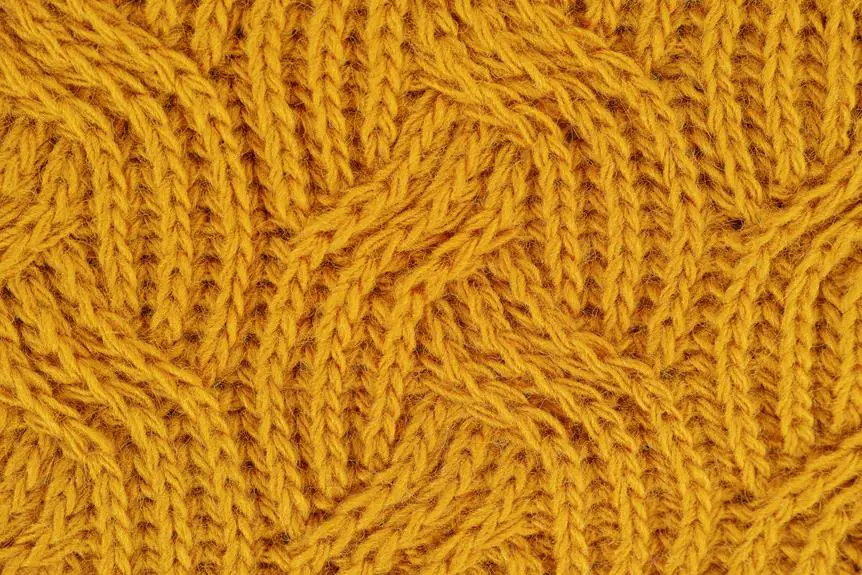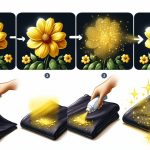You might be curious whether chenille is truly hypoallergenic and if it can provide a comfortable option for sensitive individuals. With its unique fabric structure and materials, chenille claims to minimize dust and pollen accumulation. However, it's essential to consider what that means for those prone to allergies. Are there conditions under which chenille might still pose issues? Understanding its properties in comparison to other fabrics could offer crucial insights. What other factors should you keep in mind when making your choice?
Table of Contents
What Is Chenille?
Chenille is a soft, textured fabric known for its velvety feel and luxurious appearance. This distinct fabric gets its name from the French word for “caterpillar,” reflecting its unique, plush texture.
Typically made from cotton, silk, or synthetic fibers, chenille features raised threads that create a fuzzy look and feel.
You might find chenille in various applications, from upholstery and bedding to cozy throws and clothing. Its luxurious quality often draws people in, making it an appealing choice for both decor and fashion.
When you touch chenille, you can instantly feel its softness, which adds comfort and warmth to your surroundings.
Additionally, because of its ability to absorb dyes, chenille comes in a range of vibrant colors and patterns, enabling you to customize your space or wardrobe to suit your style.
Whether you're looking to indulge in a plush sofa or wrap yourself in a soft blanket, chenille offers both aesthetics and comfort.
Properties of Chenille
When you explore the properties of chenille, you'll notice its unique material composition, which contributes to its softness and texture.
It's also essential to understand the allergens present in chenille textiles, especially if you have sensitive skin.
This knowledge can help you appreciate the benefits of using chenille in your home, making it a perfect choice for comfort without irritation.
Material Composition Overview
Made from soft polyester or cotton fibers, chenille stands out for its plush texture and hypoallergenic properties, making it an excellent choice for sensitive individuals. The unique structure of chenille creates a velvety surface that not only feels luxurious but also minimizes the accumulation of dust and pollen. This is particularly beneficial for those prone to allergies.
Polyester and cotton fibers provide durability while maintaining a soft touch. Polyester is known for its resistance to wrinkles and fading, ensuring that your chenille items retain their beauty over time. On the other hand, cotton offers breathability, which helps keep you comfortable in various climates.
Moreover, the production process of chenille often involves fewer chemical treatments than other textiles, reducing potential irritants. So, you can rest assured that choosing chenille means opting for a textile that's not just cozy but also considered safer for those with sensitivities. Overall, understanding the material composition of chenille helps you appreciate its role in creating a healthier living space for you and your family.
Allergens in Chenille Textiles
Typically, allergens are less likely to accumulate in chenille textiles due to their unique fabric structure. This softness and plushness provides a barrier that hampers dust mites and other allergens from settling in. If you're concerned about allergens in your home environment, chenille might be a suitable option for you.
1. Tightly Woven Fibers: Chenille's construction includes tightly woven fibers that prevent dust and allergens from penetrating deeply into the material.
2. Washable Quality: Most chenille textiles are machine washable, enabling you to easily remove dirt or allergens. Regular washing helps maintain a clean and allergen-free surface.
3. Low Pile: Chenille typically features a low pile texture, making it harder for allergens to cling and scatter.
Benefits for Sensitive Skin
Chenille offers a soft, gentle touch that soothes sensitive skin, making it an ideal choice for those prone to irritation.
You'll find that its plush texture not only feels luxurious but also reduces friction against your skin, minimizing the chances of rashes and discomfort. Unlike rougher fabrics, chenille's fibers cushion your skin, providing a breathable environment that helps maintain optimal comfort.
Additionally, chenille is often made from acrylic or cotton, materials that tend to be less irritating than synthetics. Its ability to wick away moisture can also help keep your skin dry, preventing potential flare-ups.
If you've got conditions like eczema or allergies, you'll appreciate how a chenille blanket or pillowcase can create a soothing atmosphere during rest.
Choosing chenille means you're opting for a fabric that complements your needs, turning everyday items into tools for comfort. By incorporating chenille into your home, you're enhancing your living space with a material designed with sensitivity in mind.
You'll discover that enjoying the plush benefits of chenille can lead to improved overall well-being, especially when it comes to caring for your delicate skin.
Common Allergens in Fabrics
Many fabrics can harbor common allergens like dust mites, mold, and pet dander, which can trigger reactions in sensitive individuals. Being aware of these allergens is crucial if you want to create a comfortable living environment.
- Dust Mites: These microscopic creatures thrive in warm, humid environments, often nesting in bedding, upholstery, and carpets. They feed on dead skin cells, and their droppings are a significant allergen.
- Mold Spores: Fabrics can absorb moisture, making them a perfect breeding ground for mold. Spores from mold can exacerbate respiratory issues and allergies, so avoid damp areas to keep mold at bay.
- Pet Dander: If you have pets, their skin flakes, saliva, and urine can accumulate in fabrics. This can lead to allergic reactions in those sensitive to animal allergens.
Understanding these common allergens will help you choose fabric materials more wisely, ensuring your home remains a safe space for everyone. Regular cleaning and fabric care also play essential roles in minimizing allergen exposure.
Chenille and Allergic Reactions
Some people may experience allergic reactions to chenille due to its texture and the fibers used in its production. If you have sensitive skin or a history of allergies, you might find chenille irritating. The plush, velvety surface can trap dust, pet dander, and other allergens, which may exacerbate your symptoms.
When it comes to the fibers, chenille is often made from synthetic materials like polyester or nylon. These fibers can sometimes cause skin irritations in individuals who are sensitive to them. In contrast, natural fibers like cotton may be less likely to trigger allergies for those with sensitivities.
If you're considering chenille for your home, think about conducting a patch test first. Rub a small piece of the fabric on your skin to see if any reaction occurs over 24 hours. Keeping your chenille clean is also crucial; regular washing can help reduce allergen buildup. You should also consider using a protective cover if you're placing chenille items on furniture you frequently use. Ultimately, being aware of your body's reactions can help you enjoy the softness of chenille without compromising your comfort.
Comparing Chenille to Other Fabrics
When comparing chenille to cotton, you'll notice that chenille often has fewer allergens, making it a better choice for sensitive individuals.
Synthetic fabrics, while generally hypoallergenic, can sometimes irritate the skin more than natural fibers.
Let's explore how they stack up against each other in terms of comfort and allergenic potential.
Chenille Vs. Cotton Allergens
Comparing chenille to cotton reveals important differences in allergenic potential, making it essential for allergy sufferers to choose wisely. While both fabrics are popular choices, they come with unique properties that can impact your comfort if you're prone to allergies.
Material Composition: Chenille is often made from polyester or a blend, which might trap more allergens compared to cotton. Cotton, being a natural fiber, tends to be more breathable and less likely to harbor dust mites and mold.
Treatment and Chemicals: Cotton is often treated with pesticides or dyes that can trigger allergic reactions. Chenille, depending on the manufacturing process, might also contain synthetic chemicals, which could irritate sensitive skin.
Maintenance: Cotton fabrics are generally easier to wash and maintain, reducing the likelihood of allergen buildup. Regular washing of cotton can help keep allergens at bay, while chenille may require more delicate care to prevent damage.
Synthetic Fabrics Comparison
While many synthetic fabrics offer unique benefits, chenille stands out for its plush texture and durability, making it a popular choice among those looking for comfort. Compared to other synthetic fabrics, like polyester or nylon, chenille presents a softer feel against your skin, enhancing your overall experience.
Polyester, while durable and resistant to wrinkles, can sometimes feel less breathable, especially in warm conditions. In contrast, chenille's texture adds a cozy warmth that polyester lacks, making it ideal for throw blankets or cushions where comfort is key.
Nylon, on the other hand, is strong and elastic but can also feel slick and cool, not providing the same nurturing embrace as chenille.
When it comes to maintenance, each synthetic fabric varies. Chenille might require more careful washing to maintain its texture, whereas polyester and nylon are generally more resistant to wear and tear.
Ultimately, if you're seeking a combination of comfort and style, chenille is likely your best bet among synthetic fabrics. It'll provide that plush indulgence while being easier on allergies, unlike some harsher options.
Care Tips for Chenille
To keep your chenille items looking their best, regular gentle cleaning and proper storage are essential. Chenille is a beautiful, textured fabric, but it can attract dust and dirt if not maintained properly.
Follow these care tips to extend the life of your chenille pieces:
- Gentle Washing: Hand wash or use the delicate cycle on your washing machine with cold water. Avoid harsh detergents; opt for a mild, bleach-free soap to prevent damage.
- Air Dry: Never wring out chenille items. Instead, lay them flat on a clean, dry towel or use a drying rack. This protects the fabric's shape and prevents shrinkage.
- Proper Storage: When you're not using your chenille pieces, store them in a cool, dry place. Avoid hanging them, as this can cause stretching. Instead, fold them neatly, keeping them away from direct sunlight to prevent fading.
Making an Informed Choice
When choosing chenille products, it's important to consider their hypoallergenic properties, especially if you or your loved ones are sensitive to allergens. While chenille is often seen as a soft and inviting fabric, not all chenille products are created equal. Understanding what features to look for can help you make an informed decision.
Consider the following factors when selecting your chenille item:
| Feature | Importance | Tips for Choosing |
|---|---|---|
| Material Composition | Determines allergenic potential | Opt for 100% cotton or synthetic blends. |
| Treatment Process | Can influence allergy reactions | Look for products labeled as hypoallergenic. |
| Certification | Ensures product safety | Choose certified textiles with low VOC emissions. |
Frequently Asked Questions
Can Chenille Attract Dust Mites Over Time?
Yes, chenille can attract dust mites over time. Its soft texture provides a cozy environment, making it appealing for these pests. Regular cleaning and maintenance can help minimize their presence and keep your space fresh.
Is Chenille Safe for Infants With Allergies?
If you're concerned about infants with allergies, chenille can be a safe option. It's soft and less likely to irritate sensitive skin, but always monitor for reactions and keep the environment clean to minimize allergens.
Does the Manufacturing Process Affect Chenille's Hypoallergenic Properties?
The manufacturing process can significantly affect chenille's hypoallergenic properties. If you choose chenille produced with chemical dyes or treatments, it might contain irritants. Always look for natural, untreated options if you're concerned about allergies.
Can Pet Dander Accumulate on Chenille Fabric?
Yes, pet dander can accumulate on chenille fabric just like it does on other materials. Regular cleaning keeps it at bay, so vacuum your chenille pieces frequently to maintain a clean, allergy-friendly environment.
What Treatments Can Enhance Chenille's Hypoallergenic Qualities?
You can enhance chenille's hypoallergenic qualities by regularly cleaning it with a vacuum or steam. Using anti-allergen sprays and opting for washable fabrics also helps prevent dust and allergens from accumulating in the fibers.
- How Does Ring Spun Cotton Affect Garment Fit and Shape Retention? - August 13, 2024
- What Are the Challenges in Producing Ring Spun Cotton? - August 13, 2024
- Is Ring Spun Cotton Suitable for Plus-Size Clothing? - August 13, 2024







